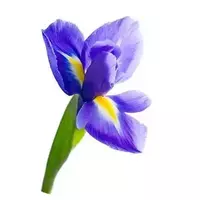Iris plant

The iris plant gives us some of the most elegant and attractive flowers. By the way, despite the fact that modern flora has, on average, about three hundred species of iris, it is the "bearded" iris that is considered the most popular. In addition, Japanese and Siberian small-colored irises are cultivated for decorative purposes, which bloom in early spring and delight half of summer with their magnificent colors.
The iris plant can have a wide variety of colors, but purple and blue specimens have gained the most popularity and love. These varieties of iris are widely used not only for decorating landscape design, but also for medical as well as culinary purposes.
One of the many legends says that the world's first irises appeared on earth more than one million years ago. The amazing beauty of this plant attracted not only birds and animals, but also the elements - water and wind, which spread the seeds of a beautiful flower throughout the planet. Irises bloomed in abundance in the district of the Etruscan settlement, later called Florence by the Romans, which in translation meant "blooming. " By the way, it is in this regard that the image of flowering iris flaunts on the Florentine coat of arms.
The useful properties of iris are highly valued in modern medicine, which uses the root of Germanic and pale or Florentine iris. From the flowers of toffee, essential oil is obtained, unusually highly valued and used in the manufacture of cosmetic and perfume products.
In addition, the iris plant is also used in the preparation of valuable spices. When ground, toffee root is often used as a flavoring agent and is also added to confectionery. Residents of Armenia often use toffee petals when cooking very tasty and healthy jam.
As is known, dried toffee seeds can be added when preparing a drink that can replace coffee, while crushed dry rhizomes are considered a great seasoning for many meals. In addition, the same raw material is used to flavour some types of alcoholic beverages.
Benefits of toffee
Dried iris root is also actively used in folk medicine. The benefits of iris in this case are due to its effective exhilarating, blood-cleansing and diuretic effects. This natural medicine is recommended for use in bladder papillomatosis and anacid gastritis.
In addition, the benefits of iris are obvious in homeopathy, where the root of this plant is a component of breast teas, all kinds of healing powders and powders. Based on the root of iris, a decoction is made that effectively helps in the event of fright and in the cathar of the stomach.
iris plants 0 kCal
The energy value of the iris plant (Ratio of proteins, fats, carbohydrates - ju):
Proteins: 0 g (~ 0 kCal)
Fats: 0 g (~ 0 kCal)
Carbohydrates: 0 g (~ 0 kCal)
 Español
Español Français
Français Português
Português Русский
Русский 简体中文
简体中文 繁體中文
繁體中文 日本語
日本語 한국어
한국어 العربية
العربية Türkçe
Türkçe Қазақ
Қазақ Deutsch
Deutsch Italiano
Italiano Українська
Українська
